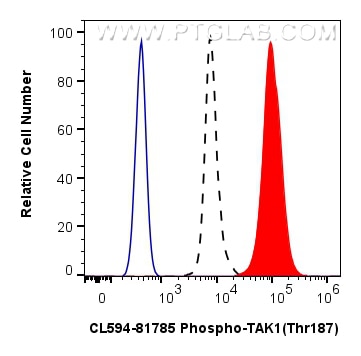Phospho-TAK1 (Thr187) Rekombinanter Antikörper
Phospho-TAK1 (Thr187) Rekombinant Antikörper für FC (Intra)
Wirt / Isotyp
Kaninchen / IgG
Getestete Reaktivität
human
Anwendung
FC (Intra)
Konjugation
CoraLite®594 Fluorescent Dye
CloneNo.
2O6
Kat-Nr. : CL594-81785
Synonyme
Geprüfte Anwendungen
| Erfolgreiche Detektion in FC (Intra) | Mit Calyculin A behandelte HEK-293-Zellen |
Empfohlene Verdünnung
| Anwendung | Verdünnung |
|---|---|
| Durchflusszytometrie (FC) (INTRA) | FC (INTRA) : 0.25 ug per 10^6 cells in a 100 µl suspension |
| It is recommended that this reagent should be titrated in each testing system to obtain optimal results. | |
| Sample-dependent, check data in validation data gallery | |
Produktinformation
CL594-81785 bindet in FC (Intra) Phospho-TAK1 (Thr187) und zeigt Reaktivität mit human
| Getestete Reaktivität | human |
| Wirt / Isotyp | Kaninchen / IgG |
| Klonalität | Rekombinant |
| Typ | Antikörper |
| Immunogen | Peptid |
| Vollständiger Name | mitogen-activated protein kinase kinase kinase 7 |
| Berechnetes Molekulargewicht | 579 aa, 64 kDa |
| Beobachtetes Molekulargewicht | 75-85 kDa |
| GenBank-Zugangsnummer | BC017715 |
| Gene symbol | TAK1 |
| Gene ID (NCBI) | 6885 |
| Konjugation | CoraLite®594 Fluorescent Dye |
| Excitation/Emission maxima wavelengths | 588 nm / 604 nm |
| Form | Liquid |
| Reinigungsmethode | Protein-A-Reinigung |
| Lagerungspuffer | PBS with 50% glycerol, 0.05% Proclin300, 0.5% BSA |
| Lagerungsbedingungen | Bei -20°C lagern. Vor Licht schützen. Nach dem Versand ein Jahr stabil. Aliquotieren ist bei -20oC Lagerung nicht notwendig. 20ul Größen enthalten 0,1% BSA. |
Hintergrundinformationen
MAP3K7(Mitogen-activated protein kinase kinase kinase 7) is also named TAK1 and belongs to the MAP kinase kinase kinase subfamily. It plays an important role in the cascades of cellular responses evoked by changes in the environment. It has been linked to interleukin-1 receptor and tumor necrosis factor receptor signaling (PMID: 16186825). It has 4 isoforms (53-55 kDa; 64-70 kDa and 75-80 kDa)produced by alternative splicing.


